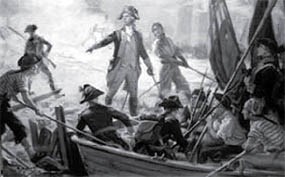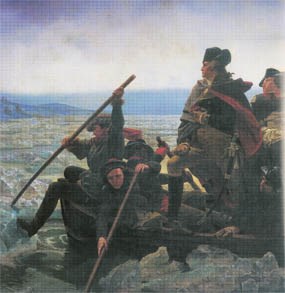
The New York-New Jersey campaign of 1776 was a difficult experience for the American forces. The British dealt a series of devastating blows to the fledgling Patriot army from August through December, nearly destroying George Washington’s forces. In many ways, it was Colonel John Glover, using expert seamanship, military leadership, and pure grit, who helped to save the American independence movement in those days that tried men’s souls. Following the crushing victory of the British over the Patriot army at the Battle of Brooklyn on August 27, Glover’s 14th Regiment, or "Marblehead Mariners" performed an extraordinary rescue feat. At 5 o’clock in the morning of the 28th he and his regiment crossed to Brooklyn from Manhattan. Following fierce fighting and British reinforcements on land and sea, General Washington made the wise decision to evacuate, and Glover directed the manning of the vessels and rafts that had been brought down through the Harlem River from the North (Hudson) River. During the first part of the summer night, the men worked with great difficult became of the ebb tide and a strong north east wind. But later, when the wind changed and a heavy fog providentially covered the Long Island side, Glover and his fishermen-soldiers were able to complete the evacuation of Washington’s 9,000 men, field pieces, heavy ordinance, and all ammunition, as well as horses, cattle, and provisions. All this was accomplished in nine hours across the East River between Brooklyn and Manhattan, oars muffled against the splashing of the water. 
In mid-October, Glover, in temporary command of a small brigade comprise of four Massachusetts Continental regiments, was sent to Eastchester (today’s St. Paul’s Church neighborhood) to disrupt a British amphibious landing designed to trap the main body of American troops in northern Manhattan. Indeed, on the morning of October 18th, he faced 4,000 Hessian and British soldiers heading ashore. Glover took advantage of the stone walls running along each side of the Split Rock Road, the obvious path for the enemy advance. The colonel from Marblehead skillfully deployed three of his regiments, alternating each behind an intersecting wall. Waiting until the Crown troops came within range, upon orders from Glover, each regiment engaged the enemy, and then moved back behind the next wall when their flanks were threatened. Massachusetts Continental troops, under the command of Colonel Glover, disrupt the British march, on the Split Rock Road, Battle of Pell's Point, October 18, 1776. Eventually, in danger of encirclement, Glover ordered his brigade back down the hill and across the Hutchinson Creek to his own 14th regiment and artillery, exchanging cannon fire with the British until nightfall. By interfering with the enemy advance, Glover enabled the main body of Washington’s troops to reach White Plains. Outnumbered and commanding a larger force than he had previously led, Glover’s tactics and leadership at Pell’s Point marked his finest hour as a field commander. 
Emanuel Leutze, 1851 Following the American retreat across New Jersey, Glover rejoined Washington’s forces on the Pennsylvania side of the Delaware River in early December. There, ten miles below Trenton, on the night of December 25th, Glover and his “Marbleheaders” ferried 2,400 troops -- again with horses, artillery and wagons -- across the Delaware River under extreme weather conditions. After marching several miles, they fought in the Battle of Trenton, and then transported the army and about 1,000 Hessian prisoners back across the river, all on the same day. Need to navigate through the exhibit? Here are some links to help you on your way. Overlooked Hero: John Glover and the American Revolution From Humble Birth to Codfish Aristocrat |
Last updated: January 25, 2024
